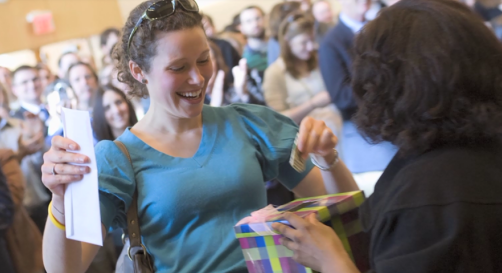
As they come up to receive their Match Day letters, students put a dollar in a kitty. The last person to receive his or her letters gets all the money.
Although it is just one simple sheet of paper printed with plain type in a plain envelope—not hand-made parchment covered in flowing calligraphy and embossed in gold—the letter a fourth-year medical student receives on Match Day is perhaps the most eagerly anticipated document of his or her medical career. The letter from the National Resident Matching Program (NRMP) has the power to elicit excited screams, tears of joy and stunned relief from students who have been waiting weeks to discover where they will begin their residencies and their medical careers.
“Students say that Match Day is more meaningful and more moving than Commencement,” said Mai-Lan Rogoff, MD, associate dean for student affairs, who has served as emcee of Match Day since 1994. “It’s the day they discover where their medical education and all their hard work will take them.”
Match Day occurs on the same date, at the same time, at every medical school in the country—the third Thursday of March (March 17 this year), at noon, Eastern Standard Time. But the process starts months earlier, in August or September when students begin applying to the residency programs they’re keen on; all applications are due by November, after which students interview at their programs of choice and rank them in order of preference. The final paperwork is submitted in mid-February, after which it goes off to the computer.
The computer is run by the NRMP, a private, not-for-profit corporation established in 1952 to provide uniformity to the residency application and appointment process. NRMP employs a rather complicated computer algorithm to match students to programs, factoring in both the order in which a student ranks the programs he or she is interested in and the order in which those programs rank the students they hope to recruit.
“It’s a dance, really,” said Dr. Rogoff.
UMMS encourages its students to think about what area of medicine they might want to go into from the very beginning, starting in the fall of their first year, says Rogoff, who co-hosts a Careers in Medicine series for medical students, with sessions in each of the first three years.
Her series co-host, Michael Ennis, MD, associate professor of family medicine & community health and co-director of the Learning Communities program, likes to take periodic “biopsies” of the class, and will ask first-year students to raise their hands if they know what field they want to pursue. A few hands will rise, but not many. As their medical education progresses and students gain exposure to the broad array of specialties and ways of practicing medicine, however, Ennis’s biopsies yield more hands: students start to focus their pursuit and opt for electives, rotations and clerkships through which they can further explore their desired areas and try on a career to see if it feels like a fit.
“With our new curriculum, students have even more, and even earlier, exposure to clinical settings, which may help them make these important decisions,” Rogoff said. During their fourth year, students meet individually with Student Affairs and other faculty to hone their choices prior to submitting their NRMP paperwork.
While the moment of truth occurs Thursday, students can log on to the registry at noon on the Monday before the Match to find out whether they have landed a residency—but they still don’t know where. Rogoff’s office also gets word Monday if a student hasn’t matched so staff can quickly help identify an open position for that student.
Nervousness and excitement builds until Thursday. Logistics—and traditions—vary from school to school, but the hard-and-fast rule is that no envelope can be opened before the clock strikes noon. At UMMS, students and their families and friends gather in the Faculty Conference Room, along with faculty and administrators, as they nervously await the distribution of envelopes. The room practically vibrates with anticipation.
“We vamp it up and make it a big exciting celebration with balloons and everything,” said Rogoff. “The chancellor speaks, the dean speaks, I give the students a little bit of information about how well they did as a class and how many students are going into primary care or specialties—but I keep an eye on that clock.”
Once high noon has come, Rogoff begins calling students up, one at a time, to receive their envelopes. In recent years, classes have opted to wait until the last student is called before opening their envelopes as a group.
“And then it’s pandemonium!” said Rogoff. “There’s cheering and jumping up and down and screaming and hugging.”
A favorite Match Day tradition holds that each student puts a dollar into a kitty when he or she receives an envelope, and the last student called gets the kitty, Rogoff said, in compensation for having to wait the longest to receive an envelope. “In reality, the student who got called first has to wait the longest to open their envelope. I see a lot of envelopes being held up to the light by the time we’re done calling names.”
“As a whole, our students do very well,” said Rogoff, noting that generally, more than half select primary care residencies. Additionally, more than half of the class selects a residency in the state, further strengthening the Medical School’s role in providing physicians for the commonwealth.